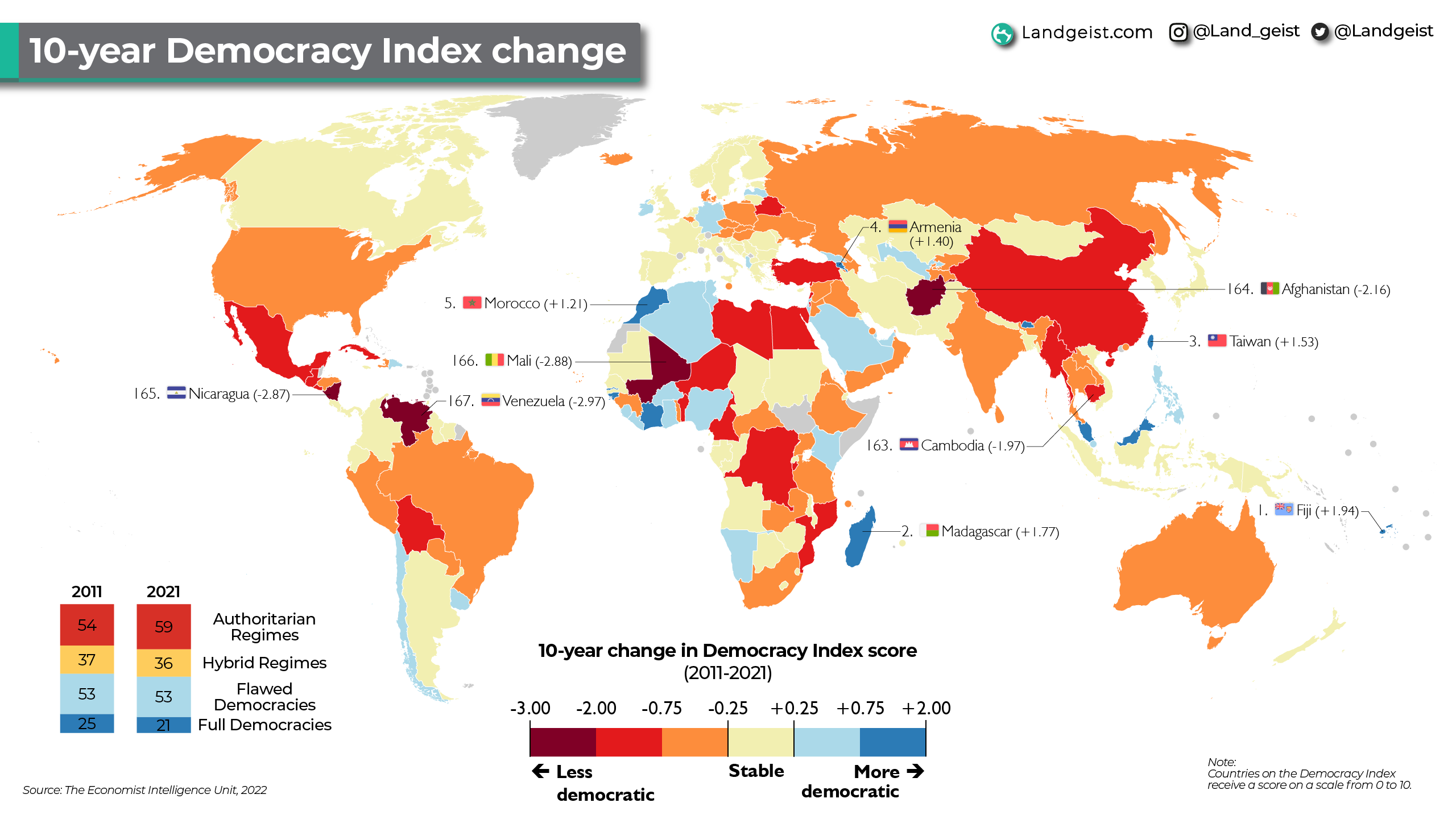How is the current state of democracy compared to 10 years ago?

Like this map and want to support Landgeist? The best way to support Landgeist, is by sharing this map. When you share this map, make sure that you credit Landgeist and link to the source article. If you share it on Instagram, just tag @Land_geist. On Twitter tag @Landgeist.
Recently, The Economist released its annual Democracy Index in which it rates how democratic each country around the world is. I already made a map about it last year, but this time I’m more interested in how the state of democracy has changed over the past 10 years. Especially since The Economist called 2021 “A new low for global democracy“.
As we can see, the map has far more orange and red than you’d want to see. Especially in Asia, Africa and Central America, quite a few countries have become less democratic. Overall, the number of authoritarian regimes in the world has increased from 54 to 59. The number of full democracies has dropped from 25 to 21.
Of all countries, Venezuela had the biggest drop, losing almost 3 points. Nicaragua and Mali also lost close to 3 points over the past 10 years. Afghanistan and Cambodia come in at the 4th and 5th place at the bottom. Interestingly, there are also several countries in red that were already in the bottom 25 in 2011. Yet they still managed to drop their score significantly lower. Belarus, China, the DR Congo and Myanmar all had a score lower than 3.2 out of 10 in 2011. Despite the low score in 2011, they managed to drop their score by more than 0.75 points.
Despite all the negatives, there are also plenty of positives on this map. Although Asia and Africa have quite a few orange and red coloured countries, they also have quite a few blue coloured countries. The largest improvement was made by Fiji, who improved its score by almost 2 points. Fiji went from being an authoritarian regime to a hybrid regime. Second is Madagascar, who also went from being an authoritarian regime to a hybrid regime. Other African countries that improved significantly are Morocco (+1.21), Côte d’Ivoire (+1.14), Gambia (+1.03) and Guinea-Bissau (+0.76).
In Asia we also see several blue countries. Taiwan is the one that improved the most, gaining 1.53 points. Despite the increasing threat from China, Taiwan’s democracy is flourishing and has grown resilient. Taiwan went from being a flawed democracy to a full democracy. Just behind Taiwan is Armenia, which has gained 1.40 points. Bhutan (+1.14) and Malaysia (+1.05) have also made a significant increase.
Overall, the largest number of countries have been stable, increasing or decreasing their score only slightly.
The Economist has ranked 167 countries on a scale from 0 to 10, based on how democratic they are. The countries are rated on 60 different indicators. These indicators are grouped into 5 categories: electoral process and pluralism; civil liberties; the functioning of government; political participation; and political culture.
Based on that score, the countries are put into one of four types of regimes:
- Full democracies: scores greater than 8
- Flawed democracies: scores greater than 6, and less than or equal to 8
- Hybrid regimes: scores greater than 4, and less than or equal to 6
- Authoritarian regimes: scores less than or equal to 4

2 comments